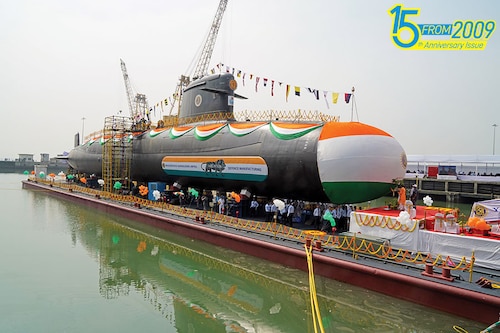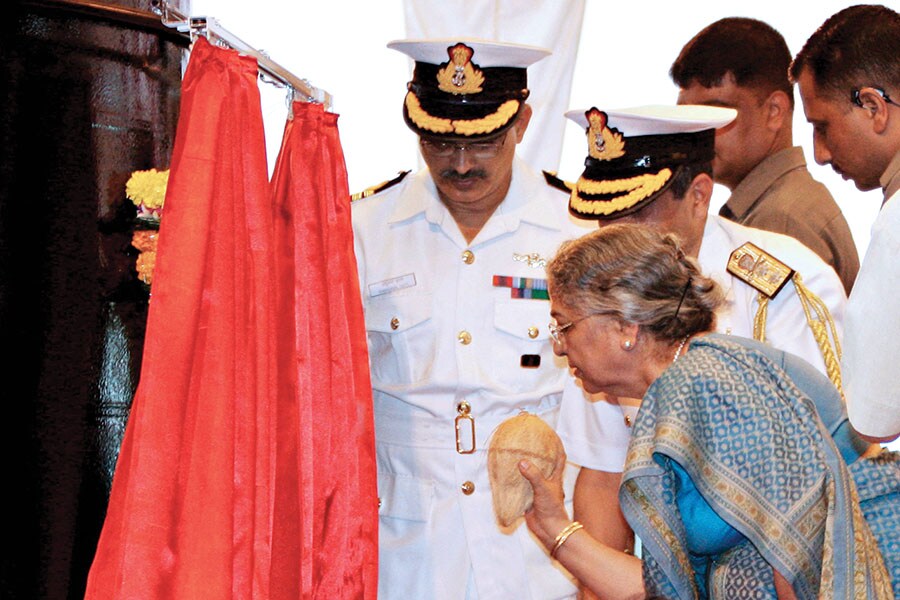India's defense sector: From increased spending to indigenisation
India's defense sector has undergone a significant transformation in 15 years. And it's only getting started


On the day India celebrated the 10th anniversary of her victory over Pakistan in the Kargil War of 1999, Gursharan Kaur, then Prime Minister Manmohan Singh’s wife, launched India’s first home-made nuclear submarine, the INS Arihant, which has been in the works since 1984 with construction beginning in 1998.
The launch, without the fanfare that follows today’s Make-in-India programmes, was, in reality, a testament to the country’s manufacturing capabilities. The hull was built by L&T, the control systems by Tata Power Strategic Engineering Division, and the systems for the steam turbine were supplied by Walchandnagar Industries. Scientists from the Bhabha Atomic Research Centre helped miniaturise the reactor to fit into the hull of the submarine.
INS Arihant’s launch was particularly significant as it put India alongside a select group of nations that have the technological capability to build and operate nuclear-propelled submarines.
Soon after the launch, India tested a nuclear-capable ballistic missile Dhanush, a naval variant of the Prithvi, boasting a 350-km range. Dhanush has a payload capacity of 500 kg, can carry both conventional and nuclear warheads, and hit targets at sea and shore.
 Since then, in the past 15 years, India’s defence sector has undergone a significant transformation, the most crucial being the indigenisation of the sector. It has only helped that the Narendra Modi government has been a big advocate of the Make-in-India programme, which has helped push India’s defence exports to a record ₹21,083 crore, up over 30 percent compared to the year-ago period.
Since then, in the past 15 years, India’s defence sector has undergone a significant transformation, the most crucial being the indigenisation of the sector. It has only helped that the Narendra Modi government has been a big advocate of the Make-in-India programme, which has helped push India’s defence exports to a record ₹21,083 crore, up over 30 percent compared to the year-ago period.
An indigenisation list, looking at import substitution, comprising the likes of Futuristic Infantry Combat Vehicles, Articulated All-Terrain Vehicles, Remotely Piloted Air Borne Vehicles up to 25 km with 2 kg payloads for the Army, and Naval Shipborne Unmanned Aerial Systems, among others, have meant that Indian manufacturers are scaling up their capacities and capabilities.
The government has also earmarked 75 percent of the capital acquisition budget for procurement from local companies. That’s also why companies such as Hindustan Aeronautics Limited (HAL) and Mazagon Dock Shipbuilders have seen tremendous interest from investors in the past few years. India’s exports from companies such as HAL include Dornier aircraft and advance light helicopters in addition to BrahMos missiles, artillery guns, radars, and armoured vehicles, “PSU companies and their vendors should lead the way on this as suggested by the recent government-to-government defence interactions," research firm, Jefferies said in a report in April. “Given this, we believe the sector is poised for double-digit growth till FY30E, and are positive on Data Patterns, HAL, and BEL."
From ₹67,000 crore in August 2022, Bengaluru-based public sector company HAL has a market capitalisation of over ₹2.48 lakh crore as of May 7, making it India’s largest public sector defence company by market capitalisation. Another public defence manufacturer, Bharat Electronic Limited (BEL) is worth ₹1.66 lakh crore, while Mazagon Dock Shipbuilders is worth ₹43,000 crore, highlighting investor confidence in the country’s defence sector.
There is also the growing importance of private companies, including Tata Advanced Systems Limited, which has tied up with the likes of Airbus to manufacture defence and commercial aircraft within India. The company will make 40 Airbus C295, a tactical airlifter that’s meant to replace the Avro Hawker Siddeley HS-748 twin-turboprop aircraft, which has been in service with the Indian Air Force since the early 1960s.
 Gursharan Kaur (in front, right), wife of former Indian Prime Minister Manmohan Singh, launches INS Arihant at a ceremony in Visakhapatnam on July 26, 2009Image: Ho / Mod / Afp Infographic: Mukesh Singh
Gursharan Kaur (in front, right), wife of former Indian Prime Minister Manmohan Singh, launches INS Arihant at a ceremony in Visakhapatnam on July 26, 2009Image: Ho / Mod / Afp Infographic: Mukesh Singh
While India remains one of the top three global defence spenders, its spending was only at 10 percent of what the US spent in 2022 and at 27 percent of China’s, highlighting the growing room for the world’s fastest-growing economy to spend on defence purchases. India is also the second-largest importer of defence equipment, accounting for 9 percent of global arms imports, with the likes of Rafale aircraft being bought from France.
The government, though, aims to nearly triple India’s annual defence production to ₹3 lakh crore by 2028-29. India has also been ramping up its nuclear weapons, especially those that are strategic. A Stockholm International Peace Research Institute report says India seems to be placing growing emphasis on longer-range weapons, including those capable of reaching targets across China.
All this means India’s love affair with its defence sector is only getting started.
First Published: May 29, 2024, 15:04
Subscribe Now